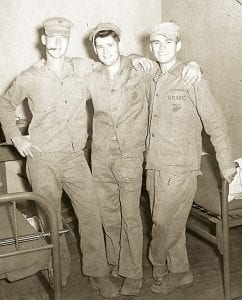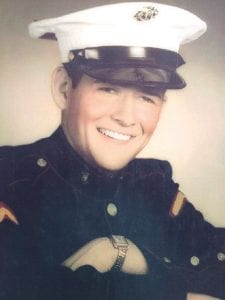Above left: Pat Finn, of Grand Marais and Minneapolis, was just 18 years old when he was deployed to Korea. The young Marine ended up in one of our nation’s worst battles, the Chosin Reservoir Campaign. Above: Corporal Finn (center) is pictured here with his buddies, Ken “Wee Willie”Wilson of St. Louis, Missouri and Hugh Feibig, of Seattle, Washington, in Hawaii as they recovered from the injuries they received during the siege.

Pat Finn of Grand Marais and Minneapolis is one of many veterans who didn’t talk about his military service for many years—despite the fact that he had been a participant in America’s third largest battle— the Chosin Reservoir Campaign in Korea.
Finn definitely didn’t know what he was in for when he lied about his age and enlisted in the Marine Corps Reserve at 15 years old. “I was always trying to be older than I was,” said Finn sheepishly over a cup of coffee at Blue Water Café.
He served until he was 18 years old and was ready to return to civilian life. Unfortunately that did not happen. It was mandatory for Marines to turn in their uniforms and gear— Finn had worn his out. He was told he needed to come up with $100 to replace them—or he could re-enlist. Finn did the latter, just as the conflict in Korea began. Finn’s military occupation specialty (MOS) was advanced rifleman and he was assigned to B. Company, 4th Infantry Battalion of Duluth and was shipped to Camp Pendleton, California, to Japan and finally to Korea, just as the North Koreans had forced their way down to the tip of Korea to Pusan.
Finn said General Douglas MacArthur was “trying to run the war out of Tokyo.” The general believed there would be “nothing to it” to push the North Koreans back. Things weren’t too bad right after they landed, said Finn. There was decent weather as they started the trek into the mountains. There was only a little sniper fire on the troops as they traveled— until they reached the crest at the Chosin Reservoir on November 25, 1950. “They knew what they were doing,” said Finn. “They let us get up there and then they pinched us.”
The Marines found out that MacArthur was wrong. “We started killing Chinese,” said Finn, although the war department insisted the Chinese were not involved. Finn and his comrades, who eventually became known as the “Chosin Few,” knew different. The 11,000 American soldiers in the campaign were ultimately surrounded by 123,000 Chinese troops.
The weather they faced was as much a challenge as the enemy. The men fought in 30 degrees below zero. “It was the worst winter recorded in that area,” said Finn, noting that it was next to impossible to dig a foxhole in the frozen ground. “We used Chinese corpses for bunkers,” he remembered.
The Marines had sleeping bags, but they learned not to use them. When Chinese troops advanced, they bayoneted anyone who didn’t get out of the sleeping bag fast enough.
“We lost a lot of people,” said Finn, recalling the horrible sight of corpses frozen in the position they died. “We had trucks piled high with dead people.”
It was also difficult to keep strength up because food was bad—the troops had a cold turkey dinner for Thanksgiving that gave many of the Marines dysentery. Even food that didn’t make people sick tasted terrible, because it had to be eaten cold. Marines carried C-rations inside their uniforms for hours just to thaw them enough to eat. The one pleasant memory was of Tootsie Rolls. Rations were air dropped to the Marines and one drop included the chocolate treat, which was edible frozen or not. “I still love ’em,” said Finn with a big smile.
Finn said he was “really green” when he got to Korea and if a more experienced Marine, Eddy Reilly, had not taken him under his wing, he would be dead. Finn recalled an incident at the height of the battle, when his position was overrun. He was face to face with an enemy soldier. When he attempted to fire, it was so cold, his rifle did not fire. Finn said he thought he was going to be shot and he called out, “He got me!” Reilly shot the attacker, saving Finn’s life.
Finn sadly said Reilly was killed on December 3. He later tried to find Reilly’s family, to let them know of his heroism. He knew Reilly was from Center Point, Iowa. He contacted the library and newspaper and neither had a record of Reilly. He drove to the Iowa town, in search of family members, but could not find anyone who knew Reilly. “I know he was real, because the air corps lists him as a real guy, but I can’t find anyone who knew him. He was my guardian angel,” said Finn.
Finn said he didn’t realize the extent of the losses. “I only knew my little piece of it,” he said. He only knew that he had been involved for 7 – 8 weeks, with fighting around the clock. The Marines had more firepower, but Finn said the enemy had the advantage of “mob force.” He said, “You’d shoot three down and three more would run up their backs, grab the dead one’s weapon and come at you. They could afford a loss of men.”
Finn eventually became one of the wounded. He suffered from frostbite, like all of the Chosin survivors, but was also “blown out” of a foxhole, receiving serious injuries to his back. When he arrived at the hospital, he was given the choice of being sent to one of three places where it was warm—Guam, the Philippines, or Hawaii. It was a no-brainer, said Finn. He wanted to get back as close as possible to the United States. He completed his recovery at Tripler Army Hospital in Hawaii and when he recovered enough stood guard duty on the beach. “We guarded the beach at Waikiki. We never had any trouble, so we must have done a good job,” joked Finn.
He was then sent to Camp Lejeune, North Carolina to finish up his military career, where he was given the job of driving a fire truck. “That didn’t work well,” chuckled Finn, who was happy to get out of the Marines as a corporal. He was offered sergeant if he stayed in, but Finn said, “I’d had enough.”
After his discharge, he went to work for a family-owned plumbing and heating company. He eventually became CEO of the firm. Because of a friend in the business—Chuck Soderholm, who retired to Grand Marais—he and his wife, Arlene visited the North Shore and decided to build a home in Grand Marais. They divide their time between Grand Marais and Minneapolis and enjoy when their children—daughter, Jessica and sons, Pat, Jon, Tim, Tom and Mike and families— are able to visit.
Finn joined a group called the “Chosin Few” that meets to talk about the horrible ordeal. “It’s surprising how much you don’t remember,” said Finn. He is glad he followed his father’s advice. When he was recovering, his dad suggested he write down the details of the Chosin campaign. Finn said he had nothing else to do, so he did and mailed it to his father. His dad typed it up and Finn has seven pages of the tale, written in the matter-of-fact manner of an 18-year-old Marine. Likely still in shock when he was writing, the young Finn shared the traumatic story—the confusion of being overrun, of comrades with lost limbs, the suffering and death. Of the last days of the struggle, he wrote, “Days and nights just came and went. We were all filthy and dirty and cold to the bone. Just walk and walk, then stop and wait to clear a roadblock or wipe out a sniper’s nest. The vehicles were so loaded with wounded and dead you couldn’t even sit down. I never thought a person could go on without sleep or proper food for so long. You can win just about any contest I guess when the prize is your life. That’s about what it amounted to, a contest, the human being against the enemy and nature.”
And finally, Finn writes of the relief of reaching Hagaru-ri, where the Marines helped rescue 100,000 Korean civilians fleeing from the communist regime. “The whole 1st Division (or what was left of it) was to meet there,” he wrote. “I got back with my outfit, there were only about 12 men left…Benny Rojas, Riggs, Jimmy Ferguson and myself went to find someplace to sleep. We found a police station. It was nice and warm…We stole lots of chow and sleeping bags and sacked out. Talk about heaven, that sure was close to it.”
Finn is proud that his unit was able to help all those refugees. He is pleased that the descendants of those refugees now live in the thriving democratic nation of South Korea and across the globe. “That was one war that was justifiable,” said Finn. “We stopped communism. If we hadn’t, all of the countries in the region would have fallen.”



Loading Comments